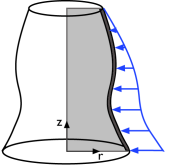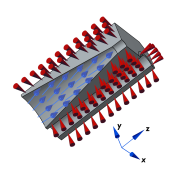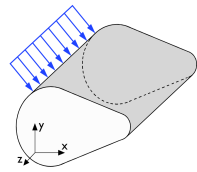The 2D physics interface for plane stress allows loads in the x and
y directions, and assumes that these are constant throughout the material’s thickness, which can vary with
x and
y. The plane stress condition prevails in a thin (compared to the in-plane dimensions) flat plate in the
xy-plane loaded only in its own plane and without any
z direction restraint.
Loads in the x and
y directions are allowed. The loads are assumed to be constant throughout the thickness of the material, but the thickness can vary with
x and
y. Formally, the plane strain condition requires that the ends of the object are constrained in the
z direction, but it is often also used for central parts of an object that is long in the
z direction (compared to the in-plane dimensions). One example is a long tunnel along the
z-axis where it is sufficient to study a unit-depth slice in the
xy-plane.
In the default version of the interface, displacements occur only in the rz-plane, and there are two degrees of freedom,
u and
w. By selecting the
Include circumferential displacement option, you can model also torsion around the axis of rotational symmetry. The azimuthal rotation degree of freedom
v is then included. In addition, many features, such as load features, allow values to be entered in the
φ direction.
The 2D axisymmetric geometry is viewed as the intersection between the original axially symmetric 3D solid and the half plane φ = 0,
r ≥ 0. Therefore, the geometry is drawn only in the half plane
r ≥ 0, and it recovers the original 3D solid by rotating the 2D geometry about the
z-axis.




